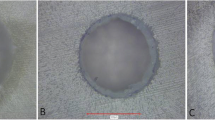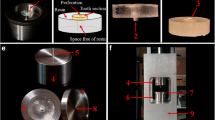Abstract
Objective
The aim of this study was to evaluate the bond strength of three calcium silicate-based root-end filling materials.
Materials and methods
The root canals of 30 single-rooted teeth were endodontically treated; their root ends were resected and root-end cavities were prepared using ultrasonic tip. The teeth were randomly divided into three groups according to the material: (1) Micro-Mega mineral trioxide aggregate (MM-MTA), (2) Biodentine, and (3) TotalFill root repair material (RRM). Push-out test was performed using universal testing machine, and failure mode was analyzed by stereomicroscope. The data were statistically analyzed using Kruskal-Wallis and Man-Whitney post hoc tests. All p values < 0.05 were considered significant.
Results
TotalFill RRM exhibited significantly higher bond strength (12.69 MPa) than Biodentine (9.34 MPa, p = 0.023) and MM-MTA (7.89 MPa, p = 0.002). The difference between Biodentine and MM-MTA was not significant (p = 0.447). Mixed failures were the most noted in all three groups. MM-MTA had more adhesive failures than Biodentine and TotalFill, and no cohesive failures, but without statistical significance (p = 0.591).
Conclusion
The bond strength was the highest for TotalFill RRM.
Clinical relevance
In order to provide a persistent apical seal, root-end filling materials should resist dislodgement under static conditions, during function and operative procedures. TotalFill RRM exhibited higher bond strength to dentin than MM-MTA and Biodentine.



Similar content being viewed by others
References
Martí Bowen E, Peñarrocha M (2006) An update in periapical surgery. Med Oral Patol Oral Cir Bucal 11:503–509
Rosales-Leal JI, Olmedo-Gaya V, Vallecillo-Capilla M, Luna-del Castillo JD (2011) Influence of cavity preparation technique (rotary vs. ultrasonic) on microleakage and marginal fit of six root-end filling materials. Med Oral Patol Oral Cir Bucal 16:185–189
Gondim EJ, Kim S, Souza-Filho FJ (2005) An investigation of microleakage from root-end fillings in ultrasonic retrograde cavities with or without finishing: a quantitative analysis. Oral Surg Oral Med Oral Pathol Oral Radiol Endod 99:755–760
Gartner AH, Dorn SO (1992) Advances in endodontic surgery. Dent Clin N Am 36:357–378
Torabinejad M, Higa RK, McKendry DJ, Pitt Ford TR (1994) Dye leakage of four root end filling materials: effects of blood contamination. J Endod 20:159–163
Parirokh M, Torabinejad M (2010) Mineral trioxide aggregate: a comprehensive literature review––part I: chemical, physical and antibacterial properties. J Endod 36:16–27
Setbon HM, Devaux J, Iserentant A, Leloup G, Leprince JG (2014) Influence of composition on setting kinetics of new injectable and/or fast setting tricalcium silicate cements. Dent Mater 30:1291–1303
Tagger M, Tagger E, Tjan AHL, Bakland LK (2002) Measurement of adhesion of endodontic sealers to dentin. J Endod 28:351–354
Huffman BP, Mai S, Pinna L, Weller RN, Primus CM, Gutmann JL, Pashley DH, Tay FR (2009) Dislocation resistance of ProRoot Endo Sealer, a calcium silicate-based root canal sealer, from radicular dentin. Int Endod J 42:34–46
Faul F, Erdfelder E, Lang AG, Buchner AG (2007) Power 3: a flexible statistical power analysis program for the social, behavioral, and biomedical sciences. Behav Res Methods 39:175–191
Pane ES, Palamara JE, Messer HH (2013) Critical evaluation of the push-out test for root canal filling materials. J Endod 39:669–673
Marques JH, Silva-Sousa YT, Rached-Junior FJ, Mazzi-Chaves JF, Miranda CE, Silva SR et al (2015) New methodology to evaluate bond strength of root-end filling materials. Braz Dent J 26:288–291
do Carmo SS, Néspoli FFP, Bachmann L, Miranda CES, Castro-Raucci LMS, Oliveira IR, Raucci-Neto W (2017) Influence of early mineral deposits of silicate- and aluminate-based cements on push-out bond strength to root dentin. Int Endod J. https://doi.org/10.1111/iej.12791
Torabinejad M, Watson TF, Pitt Ford TR (1993) Sealing ability of a mineral trioxide aggregate when used as a root end filling material. J Endod 19:591–595
Küçükkaya SE, Aksel H, Serper A (2016) Effect of placement technique on the push-out bond strength of calcium-silicate based cements. Dent Mater J 35:742–747
Carvalho NK, Prado MC, Senna PM, Neves AA, Souza EM, Fidel SR, Sassone LM, Silva EJ (2016) Do smear-layer removal agents affect the push-out bond strength of calcium-silicate based endodontic sealers? Int Endod J. https://doi.org/10.1111/iej.12662
Celik D, Er K, Serper A, Tasdemir T, Ceyhanli KT (2014) Push-out bond strength of three calcium silicate cements to root canal dentin after two different irrigation regimes. Clin Oral Investig 18:1141–1146
Han L, Okiji T (2011) Uptake of calcium and silicon released from calcium silicate-based endodontic materials into root canal dentin. Int Endod J 44:1081–1087
Villat C, Tran XV, Pradelle-Plasse N, Ponthiaux P, Wenger F, Grosgogeat B, Colon P (2010) Impedance methodology: a new way to characterize the setting reaction of dental cements. Dent Mater 26:1127–1132
Grech L, Mallia B, Camilleri J (2013) Investigation of the physical properties of tricalcium silicate cement-based root-end filling materials. Dent Mater 29:e20–e28
Camilleri J, Sorrentino F, Damidot D (2013) Investigation of the hydration and bioactivity of radiopacified tricalcium silicate cement, Biodentine and MTA Angelus. Dent Mater 29:580–593
Bortoluzzi EA, Broon NJ, Bramante CM, Felippe WT, Tanomaru Filho M, Esberard RM (2009) The influence of calcium chloride on the setting time, solubility, disintegration, and pH of mineral trioxide aggregate and white Portland cement with a radiopacifier. J Endod 35:550–554
Darvell BW, RC W (2011) “MTA”––an hydraulic silicate cement: review update and setting reaction. Dent Mater 27:407–422
Nagas E, Cehreli ZC, Uyanik MO, Vallittu PK, Lassila LV (2016) Effect of several intracanal medicaments on the push-out bond strength of ProRoot MTA and Biodentine. Int Endod J 49:184–188
Guneser MB, Akbulut MB, Eldeniz AU (2013) Effect of various endodontic irrigants on the push-out bond strength of biodentine and conventional root perforation repair materials. J Endod 39:380–384
Guo YJ, TF D, Li HB, Shen Y, Mobuchon C, Hieawy A, Wang ZJ, Yang Y, Ma J, Haapasalo M (2016) Physical properties and hydration behavior of a fast setting bioceramic endodontic material. BMC Oral Health 16:23
Mahmood K, Essam O, Dodd M, Jarad F. TotalFill putty in action. Endodontic practice. https://www.endopracticeus.com/ce-articles/ce-totalfill-putty-in-action/ . Accessed 1 February 2017
Niu LN, Jiao K, Wang TD, Zhang W, Camilleri J, Bergeron BE, Feng HL, Mao J, Chen JH, Pashley DH, Tay FR (2014) A review of the bioactivity of hydraulic calcium silicate cements. J Dent 42:517–533
Han L, Kodama S, Okiji T (2015) Evaluation of calcium-releasing and apatite-forming abilities of fast-setting calcium silicate-based endodontic materials. Int Endod J 48:124–130
Gandolfi MG, Iacono F, Agee K, Siboni F, Tay F, Pashley DH, Prati C (2009) Setting time and expansion in different soaking media of experimental accelerated calcium-silicate cements and ProRoot MTA. Oral Surg Oral Med Oral Pathol Oral Radiol Endod 108:e39–e45
Vivan RR, Guerreiro-Tanomaru JM, Bernardes RA, Reis JM, Hungaro Duarte MA, Tanomaru-Filho M (2016) Effect of ultrasonic tip and root-end filling material on bond strength. Clin Oral Investig 20(8):2007–2011
Shokouhinejad N, Nekoofar MH, Iravani A, Kharrazifard MJ, Dummer PM (2010) Effect of acidic environment on the push-out bond strength of mineral trioxide aggregate. J Endod 36:871–874
Vivan RR, Guerreiro-Tanomaru JM, Bosso-Martelo R, Costa BC, Duarte MA, Tanomaru-Filho M (2016) Push-out bond strength of root-end filling materials. Braz Dent J 27:332–335
Acknowledgements
This work was supported by a grant from the University of Zagreb, Croatia, in 2014.
Funding
This work was supported by a grant from the University of Zagreb, Croatia, in 2014.
Author information
Authors and Affiliations
Corresponding author
Ethics declarations
Conflict of interest
The authors declare that they have no conflict of interest.
Ethical approval
This article does not contain any studies with human participants or animals performed by any of the authors. The article contains in vitro studies on human teeth where the extraction was indicated. The research was approved by the Ethical Committee of the School of Dental Medicine, University of Zagreb.
Informed consent
The participants signed the informed consent allowing the usage of their teeth in the study.
Rights and permissions
About this article
Cite this article
Kadić, S., Baraba, A., Miletić, I. et al. Push-out bond strength of three different calcium silicate-based root-end filling materials after ultrasonic retrograde cavity preparation. Clin Oral Invest 22, 1559–1565 (2018). https://doi.org/10.1007/s00784-017-2244-6
Received:
Accepted:
Published:
Issue Date:
DOI: https://doi.org/10.1007/s00784-017-2244-6




